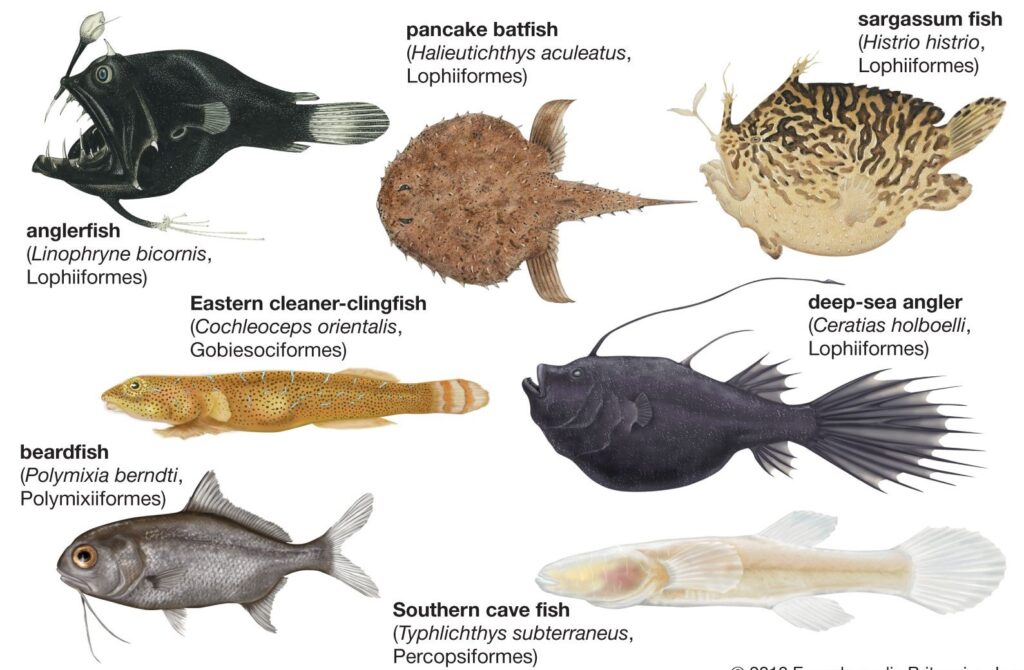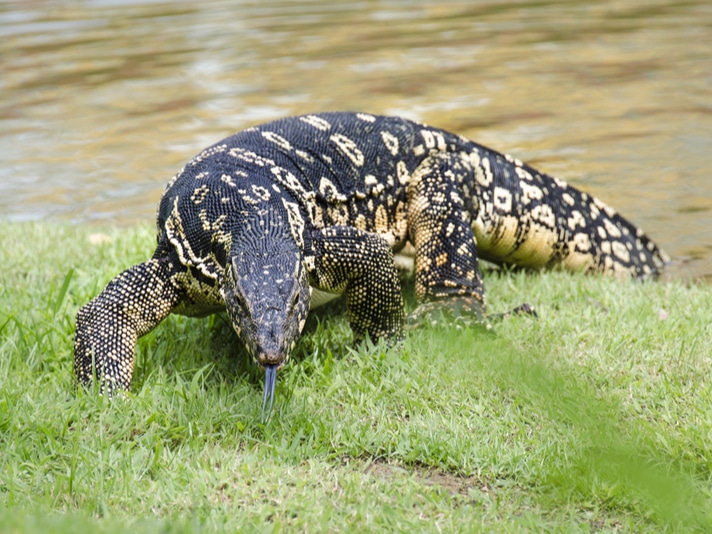The anglerfish is a fascinating and bizarre creature that thrives in the depths of the ocean. Known for its unique hunting methods and extreme adaptations to its environment, this fish has captivated scientists and the general public alike. Below is an overview of the anglerfish, written in an accessible and engaging manner.
Overview of Anglerfish
Anglerfish belong to the order Lophiiformes, which includes around 210 species. These bony fish are named for their distinctive method of predation, using a modified dorsal fin spine as a “fishing rod” tipped with a luminous “bait” to attract prey. This adaptation is most prominent in females, who dominate their ecosystem with their unique hunting abilities.
Anglerfish are found worldwide, inhabiting both shallow coastal waters and the dark depths of the ocean. They are divided into several groups, including batfish, goosefish, frogfish, and deep-sea anglerfish.
Anatomy and Physical Features
Anglerfish are known for their unusual appearance, which is well-suited to their deep-sea environment:
- Size and Shape: While most anglerfish are relatively small (around 12 inches or 30 cm), some species can grow up to 4 feet (1.2 meters) long. They have disproportionately large heads and wide mouths filled with sharp, inward-curving teeth.
- Expandable Jaws and Stomach: Their jaws and stomachs are highly flexible, allowing them to swallow prey up to twice their size. This adaptation is crucial in the deep sea, where food is scarce.
- Bioluminescent Lure: The most iconic feature of anglerfish is the bioluminescent lure (esca) on their heads. This lure contains symbiotic bacteria that produce light, attracting prey in the darkness of the deep ocean.
- Coloration: Anglerfish typically have dark, muted colors like brown or black to blend into their surroundings.

Habitat and Distribution
Anglerfish are found across various marine environments:
- Deep-Sea Species: Many anglerfish live in the abyssal zones of the ocean, thousands of meters below the surface. These regions are characterized by complete darkness, high pressure, and low temperatures.
- Benthic vs. Pelagic: Some species dwell near the seafloor (benthic), while others swim freely in open water (pelagic). Deep-sea anglerfish are usually pelagic, while frogfishes and goosefishes are benthic.
Hunting and Diet
Anglerfish are ambush predators that rely on stealth and deception to catch their prey:
- Luring Prey: The bioluminescent lure mimics small organisms or movements, attracting fish and invertebrates. The anglerfish wiggles its lure like bait on a fishing line until prey comes close enough to be swallowed.
- Diet: Their diet includes crustaceans, snails, small fish, squid, and even octopuses. Thanks to their expandable jaws and stomachs, they can consume prey much larger than themselves.
Reproduction and Sexual Dimorphism
Anglerfish exhibit extreme sexual dimorphism:
- Females vs. Males: Female anglerfish are much larger than males and possess the iconic fishing rod-like lure. Males are significantly smaller and lack this feature.
- Parasitic Mating: In some deep-sea species (e.g., Ceratioidei), males attach themselves permanently to females by biting into their skin. Over time, their bodies fuse together, sharing bloodstreams. The male becomes entirely dependent on the female for nutrients while providing sperm for reproduction.
This unique reproductive strategy ensures that males can find mates in the vast darkness of the deep sea.
Evolutionary History
The evolutionary history of anglerfish dates back millions of years:
- Fossils from as early as the Eocene epoch show significant diversification among anglerfish families.
- Molecular studies suggest that anglerfish originated during or shortly after the Cretaceous period, adapting rapidly to deep-sea environments following major extinction events.
Adaptations for Deep-Sea Survival
Living in one of Earth’s harshest environments has led to remarkable adaptations:
- Bioluminescence: The ability to produce light not only helps with hunting but also deters predators.
- Enhanced Vision: Anglerfish have adapted eyes that function well in low-light conditions.
- Energy Efficiency: Their slow metabolism allows them to conserve energy in a habitat with limited food resources.

Notable Species
Some well-known species of anglerfish include:
- Footballfish (Himantolophus groenlandicus): This species was one of the first anglerfish discovered by scientists in 1833.
- Black Seadevils (Melanocetus johnsonii): These iconic deep-sea anglers are known for their terrifying appearance.
Fun Facts About Anglerfish
- Anglerfish can swallow prey twice their size due to their flexible jaws and stomachs.
- Only females hunt with bioluminescent lures; males rely on females for survival after mating.
- Despite their fearsome reputation, some species live closer to the surface and pose no threat to humans.
- Their glowing lures result from symbiotic bacteria that generate light through chemical reactions.
The anglerfish remains one of the most mysterious creatures of the ocean depths. Its unique adaptations make it a marvel of evolution, perfectly suited to life in an environment few other organisms can endure. Whether admired for its ingenuity or feared for its appearance, there’s no denying that the anglerfish is one of nature’s most extraordinary creations.



